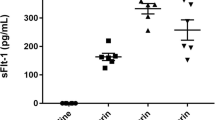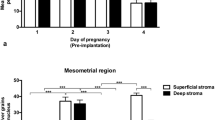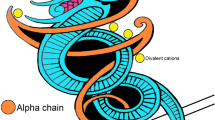Abstract
The presence and distribution of heparin-binding epidermal growth factor in rat uterine epithelial cells was determined immunohistochemically and localized ultrastructurally. Rat uterine tissue was examined on days 1, 3, 6 and 8 of pregnancy and it was found that while presence of this growth factor was evident from day 1, spatial reorganization occurred by the time of blastocyst implantation. Strong apical staining was evident from day 6 to day 8, day 6 being the approximate time of blastocyst implantation. Electron microscopy further revealed that this growth factor while shown to be expressed very strongly apically from day 6, actually localized on the plasma membrane only after attachment of the blastocyst. This suggests that heparin-binding epidermal growth factor is not involved in the initial stages of implantation but is more likely involved in the post attachment stages of pregnancy.
Similar content being viewed by others
References
Birdsall MA, Hopkisson JF, Grant KE, Barlow DH, Mardon HJ (1996) Expression of heparan-binding epidermal growth factor messenger RNA in the human endometrium. Mol Human Reprod 2: 31–34.
Brigstock DR (1991) Growth factors in the uterus: Steroidal regulation and biological actions. Bailliere's Clin Endocrin Metab 5: 791–808.
Carson DD, Tang J-P, Julian J (1993) Heparan sulfate proteoglycan (perlecan) expression by mouse embryos during acquisition of attachment competence. Dev Biol 155: 97–106.
Dardik A, Smith RM, Schultz RM (1992) Colocalisation of transforming growth factor-? and a functional epidermal growth factor receptor (EGFR) to the inner cell mass and preferential localisation of theEGFR on the basolateral surface of the trophectoderm in the mouse blastocyst. Dev Biol 154: 396–409.
Das SK, Wang X-N, Paria BC, Damm D, Abraham JA, Klagsbrun M, Andrews GK, Dey SK(1994) Heparin-binding EGF-like growth factor gene is induced in the mouse uterus temporally by the blastocyst solely at the site of its apposition: A possible ligand for interaction with blastocyst EGF-receptor in implantation. Development 120: 1071–1083.
Higashiyama S, Abraham JA, Miller J, Fiddes JC, Klagsbrun M (1991) A heparin-binding growth factor secreted by macrophage-like cells that is related to EGF. Science 251: 936–939.
Higashiyama S, Lau K, Besner GE, Abrahams JA, Klagsbrun M (1992) Structure of heparin-binding EGF-like growth factor. Multiple forms, primary structure and glycosylation of the mature protein. J Biol Chem 267: 6205–6212.
Higashiyama SR, Iwamoto K, Goishi G, Raab G, Taniguchi M, Klagsbrun M, Mekada E (1995) The membrane protein CD9/DRAP27 potentiates the juxtacrine growth factor activity of the membraneanchored heparin-binding EGF like growth factor (HB-EGF). J Cell Biol 128: 929–938.
Iwamoto R, Higashiyama S, Mitamura T, Taniguchi N, Klagsbrun M, Mekada E (1994) Heparin-binding EGF-like growth factor, which acts as the diphtheria toxin receptor, forms a complex with membrane protein DRAP27/CD9, which up-regulates functional receptors and diphtheria toxin sensitivity. EMBO J 13: 2322–2330.
Kim GY, Besner GE, Steffen CL, Mccarthy DW, Downing MT, Luquette MH, Abad MS, Brigstock DR (1995) Purification of heparinbinding epidermal growth factor-like growth factor from pig uterine luminal flushings, and its production by endometrial tissues. Biol Reprod 52: 561–571.
Leach RE, Khalifa R, Ramirez ND, Das SK, Wang J, Dey SK, Romero R, Armant R (1999) Multiple roles for heparin-binding epidermal growth factor-like growth factor are suggested by its cell-specific expression during the human endometrial cycle and early placentation. J Clin Endo Metab 84: 3355–3363.
Massagué J (1992) Receptors for the TGF-beta family. Cell 69: 1067–1070.
Mitamura T, Higashiyamas S, Taniguchi N, Klagsburn M, Mekada E (1995) Diphtheria toxin binds to the epidermal growth factor (EGF)-like domain of human heparin-binding EGF-like growth factor/ diphtheria toxin receptor and inhibits specifically its mitogenic activity. J Biol Chem 270: 1015–1019.
Ono M, Raab G, Lau K, Abraham JA, Klagsbrun M (1994) Purification and characterisation of transmembrane forms of heparin-binding EGFlike growth factor. J Biol Chem 269: 31315–31321.
Paria BC, Das SK, Andrews GK, Dey SK (1993) Expression of the epidermal growth factor receptor gene is regulated in mouse blastocysts during delayed implantation. Proc Natl Acad Sci USA 90: 55–59.
Png FY, Murphy CR (1997) The plasma membrane transformation does not last: Microvilli return to the apical plasma membrane of uterine epithelial cells during the peri-implantation period. Eur J Morphol 35: 19–24.
Png FY, Murphy CR (2000) Closure of the uterine lumen and the plasma membrane transformation do not require blastocyst implantation. Eur J Morph 38: 122–127.
Raab G, Kover K, Paria BC, Dey SK, Ezzell RM, Klagsbrun M (1996) Mouse preimplantation blastocysts adhere to cells expressing the transmembrane form of heparin-binding EGF-like growth factor. Development 122: 637–645.
Ruoslahti E, Yamaguchi Y (1991) Proteoglycans as modulator of growth factor activities. Cell 64: 867–869.
Rusnati M, Urbinati C, Presta M (1993) Internalization of basic fibroblast growth factor (?FGF) in cultured endothelial cells: Role of the low affinity heparin-like bFGF receptors. J Cell Physiol 154: 152–161.
Saksela O, Moscatelli D, Sommer A, Rifkin DB (1988) Endothelial cell-derived heparan sulfate binds basic fibroblast growth factor and protects it from proteolytic degradation. J Cell Biol 107: 743–751.
Slater M, Murphy CR (1999) Chondroitin sulphate and heparan sulfate proteoglycan are sequentially expressed in the uterine extracellular matrix during early pregnancy in the rat. Matrix Biol 18: 125–131.
Smith SK (1994) Growth factors in the human endometrium. Human Reprod Update 9: 936–946.
Sommer A, Rifkin DB (1989) Interaction of heparin with human basic fibroblast growth factor: Protection of the angiogenic protein from proteolytic degradation by a glycosaminoglycan. J Cell Physiol 138: 215–220.
Tamada H, Higashiyama C, Takano H, Kawate N, Inaba T, Sawada T (1999) The effects of heparin-binding epidermal growth factor-like growth factor on preimplantation-embryo development and implantation in the rat. Life Sci 64: 1967–1973.
Wegner CC, Carson DD (1994) Cell adhesion process in implantation. Oxf Rev Reprod Biol 16: 87–137.
Wiley LM, Wu J-X, Harari I, Adamson ED (1992) Epidermal growth factor receptor mRNA and protein increase after the four-cell preimplantation stage in murine development. Dev Biol 149: 247–260.
Wilson O, Jacobs AL, Stewart S, Carson DD (1990) Expression of externally-disposed heparin/heparan sulfate binding sites by uterine epithelial cells. J Cell Physiol 143: 60–67.
Yamaguchi Y, Mann DM, Ruoslahti E (1990) Negative regulation of transforming growth factor-? by the proteoglycan decorin. Nature (Lond.) 346: 281–284.
Yoo HJ, Barlow DH, Mardon HJ (1997) Temporal and spatial regulation of expression of heparan-binding epidermal growth factor-like growth factor in the human endometrium:Apossible role in blastocyst implantation. Dev Genet 21: 102–108.
Yoshinaga K (1988) Uterine receptivity for blastocyst implantation. Ann NY Acad Sci 541: 424–431.
Yue A-P, Yang Z-M, Li SJ, Wang H-B, Harper MJK (2000) Epidermal growth factor family in rhesus monkey uterus during the menstrual cycle and early pregnancy. Mol Reprod Dev 55: 164–174.
Zhang Z, Funk C, Glasser SR, Mulholland J (1994a) Progesterone regulation of heparin-binding epidermal growth factor-like growth factor gene expression during sensitization and decidualization in the rat uterus: effects of the antiprogestin, ZK 98.299. Endocrin 135: 1256–1263.
Zhang Z, Funk C, Roy D, Glasser S, Mulholland J (1994b) Heparinbinding epidermal growth factor-like growth factor is differentially regulated by progesterone and estradiol in rat uterine epithelial and stromal cells. Endocrin 134: 1089–1094.
Author information
Authors and Affiliations
Rights and permissions
About this article
Cite this article
Isaacs, J., Murphy, C.R. Heparin-binding EGF-like Growth Factor is seen on the Extracellular Surface of Uterine Epithelial Cells only after the Initial Stages of Blastocyst Attachment. Histochem J 34, 339–343 (2002). https://doi.org/10.1023/A:1023334727288
Issue Date:
DOI: https://doi.org/10.1023/A:1023334727288




